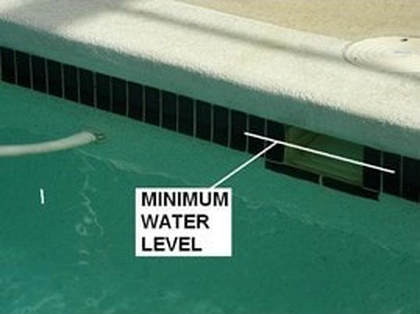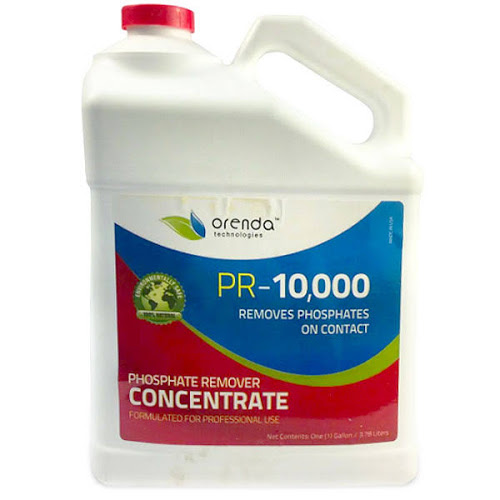 This is the most common question homeowners ask me, and it’s the most basic one. Weather someone is new to being a pool owner or a veteran pool owner, I’m often asked. Where should I keep the water level. For pool owners that have an automatic pool water leveler this is a set it and forget it situation baring any problems with your automatic leveling system which should be checked monthly by your pool service. Often we find the older auto fill systems have worn or broken parts and the float needs replaced the more recent ones are more durable and sustainable. Ideally for best results you want your pool water level 1/3 to ½ way up the skimmer throat. This is the opening in your tile where the surface debris is skimmed or sucked off the surface. Water level too high and the water flow is slowed down to the point that debris can pass right by the skimmer opening without being sucked inside and filtered.
Too low of a water level and the pump will lose its prime and you are risking possible damage to your pool pump from overheating and running dry, a very costly repair. You also will experience unhealthy swimming conditions from lack of circulation and filtration. If you have a salt chlorination system your salt cell will only produce chlorine with consistent flow high enough to trigger the flow switch. All of which will lead to an algae bloom. If you are unsure where to keep your pool water level, please don’t hesitate to ask your pool service or a pool professional. What are Phosphates? Phosphates are chemical compounds that contain phosphorus. In addition to phosphorus, phosphates contain oxygen and sometimes hydrogen. Phosphates are a biological building block that is constantly being introduced to your pool water and nourishing algae. Phosphorus is a primary food source for aquatic plants including all types of algae. Phosphate compounds are broken down into their simplest form, orthophosphates, in one of the following three ways: Oxidation (converting compounds into oxides) Hydrolysis (decomposition by water, and Enzymatic digestion. Regardless of how it happens, if phosphates are allowed to remain present in pool or spa water they will be reduced to orthophosphates, which are the only form of phosphates that algae can digest. Orthophosphate levels should remain below 100-125 ppb (parts per billion). Once levels exceed 200 ppb, algae becomes increasingly resistant to sanitizers, including chlorine shock. Excessive levels of orthophosphate, such as 1,000 ppb or more, should be brought under control with a phosphate remover such as Natural Chemistry Phos-free or Bio-dex Phosphate remover plus. Phosphates are the most overlooked chemical test performed on a pool. Most 5 and 7 point dip test strips do not test for phosphate. Many pool owners don’t know about phosphates until it’s too late. Phosphate levels should be measured at least once a month. Sources of Phosphates The largest source of phosphates entering your pool come from the public water systems. Municipal water treatment plants commonly add phosphates to the drinking water as a corrosion inhibitor to prevent the leaching of lead and copper from pipes and fixtures. Inorganic phosphates (e.g., phosphoric acid, zinc phosphate, and sodium phosphate) are added to the water to create orthophosphate, which forms a protective coating of insoluble mineral scale on the inside of service lines and household plumbing. The coating serves as a liner that keeps corrosion elements in water from dissolving some of the metal in the drinking water. As a result, lead and copper levels in the water will remain low. The key to ensuring that orthophosphate reduces lead and copper levels, is for Public water systems to maintain proper orthophosphate levels. The health effects of drinking water with phosphates are not known. The Food and Drug Administration (FDA) has issued a report on the toxicology of inorganic phosphates as food ingredients. The FDA considers phosphates as a food additive to be "generally recognized as safe." The challenge with phosphates is that they are constantly being introduced into your swimming pool water. They are found in lawn and garden fertilizers, decaying vegetation, municipal water, cosmetic items on bathers, and even other pool chemicals. This means a fresh batch of phosphates enter your water when any of the following occur:
How to determine if you have a high phosphate level Use phosphate specific test strips. These strips are highly accurate and measure orthophosphate levels in 10 seconds. They have the widest testing range available on the market, at 0 – 6,000 ppb. (parts per billion). Water tests should be conducted weekly during peak swimming season and monthly during the off-season. The best part – this test kit only costs about $15.00 which is money you will save on shock and excess sanitizers to clear up algae blooms caused by high phosphate levels.  Why are phosphates bad Sixty percent of pool owners experience two full algae blooms every season. So, what causes these blooms and how can we prevent them. Phosphates are algae food they are needed to complete the photosynthesis process and promote algae blooms, once algae starts to bloom the available chlorine in your pool is consumed at an alarming rate as it tries to fight the algae. With no available chlorine to sanitize your pool it becomes helpless and starts to turn green and turbid specially in the warm summer months, Algae loves to thrive in warm dark waters. Phosphates plus low chlorine equals disaster.  How do you get rid of Phosphates There is no amount of chlorine that will kill phosphates. Special chemicals are needed to trap and reduce the level of the phosphates from swimming pool water. Phosphates can never be completely removed, but can be managed at a low level. This process typically takes two service visits to complete in full. Our first visit we brush down all walls and remove all debris from the baskets. We need to insure that there is proper flow with your equipment in order for the treatment to work correctly. If your filter is in need of cleaning we will recommend doing this before we start the treatment. We then add our chemicals to the water of your pool. The amount of chemicals that we use is determined by the amount of water the pool carries. These chemicals need to circulate in your system for the next 24 hours. Pool Phosphate Removal Tips:
How to prevent Phosphates from building up to a dangerous level
It is important to remember that phosphate removal is a preventative measure, if you have active algae present in the pool, treat it with chlorine shock and algaecide first, then follow up with a phosphate remover to prevent reoccurrence. As algae die, they release phosphates in to the water, making it more likely that algae will return, creating a vicious cycle of expensive to treat algae bloom after algae bloom.
As a swimming pool owner, you are guaranteed to run into some sort of problem with your pool from time to time. With regular maintenance and inspection, you can usually catch problems in the beginning stages before they become bigger more expensive problems. Your pool is fun, your pool is also an investment and requires maintenance. Regular routine swimming pool maintenance preferably by a professional is advised to prolong the life of your swimming pool. A large majority of pool problems are caused by lack of maintenance or improper maintenance. EXCESSIVELY ROUGH POOL SURFACE
This can be caused by many different things, the most common being poor water chemistry over a prolonged period of time. Concrete and pebble pools can have different finishing techniques and materials used which can also cause the surface to feel rough on your feet. Improperly balanced pH, improper alkalinity aggressive fill water, acid rain, high calcium hardness in the water, improper pool plaster starts up techniques, craze cracks, plaster delamination pitting, and calcium nodules are all possible scenarios that would cause a rough pool surface, this is why it’s so important to have your pool and it’s chemistry monitored and adjusted weekly by a pool professional who is trained and educated to look out for and correct these issues before they becoming big expensive problems. STRUCTURAL CRACKING A separation or crack in plaster and or concrete shell of the pool. Most commonly due to ground movement and improper design and or improper construction techniques. A swimming pool must be engineered and constructed to withstand unstable or expansive soil and built to the specifics of the soil sample that should be obtained and analyzed prior to construction. If not built in accordance to the engineering or according to the design a pool may structurally fail and leak water. PLASTER CRACKING & DELAMINATION small hairline plaster surface cracking referred to as craze cracking is most commonly due to improper application of the swimming pools plaster surface and an improper mix of the surface plaster. Most commonly too much calcium carbonate added to the mix which causes shrinkage of the plaster. This calcium is added to the plaster to increase its drying time and hardness. These surface cracks can promote algae growth, staining, and produce calcium nodules eventually resulting in the need to completely remove and replace the swimming pools surface. DISCOLORATION / MOTTLING (blotchy pool surface) Due to swimming pool plaster’s porous nature it is susceptible to staining. Pauses while filling the pool can leave a ring around the waterline, improper trawling techniques while the plaster is being installed, improper water chemistry, filling a pool too soon, improper mix of plaster being applied can all cause spotting and mottling in your pool. There are also many many different factors and causes of staining, from organic material such as leaves and dirt sitting on the pools plaster for a period of time, metal stains from fill water and improperly balanced water chemistry, copper from plumbing and heater elements, foreign objects being left on the pools surface. Sequestrants and stain removers can be used to effectively treat surface staining. ALGAE / GREEN POOL Probably the most common problem pool owners are familiar with, most commonly due to improper circulation, not enough circulation and or improper water chemistry balance, low sanitizer. Using a chlorine based shock and elevating the chlorine level 3x-5x the normal and a clean filter will solve this problem. CLOGGED FILTER / LOW CIRCULATION As your filter does its job it builds up pressure by trapping the dirt and organic waste in the filter, eventually it can’t filter anymore and needs taken apart cleaned and recharged. Don’t worry this is a good thing. A normal filter on a normal size pool should be cleaned and recharged 3-4x a year CLOUDY / TURBID WATER I’d say cloudy turbid water is one of the trickiest of problems to diagnose, could be cause by a dirty filter, rain, low chlorine, heavy use, usually resolved within a couple hours with proper treatment. This problem usually arises after heavy rains dilute the pools chemistry or the first couple weeks of summer when the summers hot sun starts to evaporate the free available chlorine in your pool. Cyanuric acid (conditioner) is needed in the warm months to protect the pools chlorine reserve and stop the suns UV rays from zapping your chlorine right out of your pool. The solution is to maintain 50-70ppm cyanuric acid and 3-5ppm chlorine level. A cloudy looking pool is the pools way of telling you something is unbalanced asking you for help before it gets really bad. |
AuthorWrite something about yourself. No need to be fancy, just an overview. Archives
August 2018
Categories
All
|
